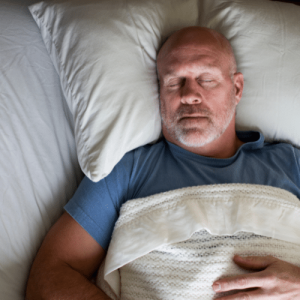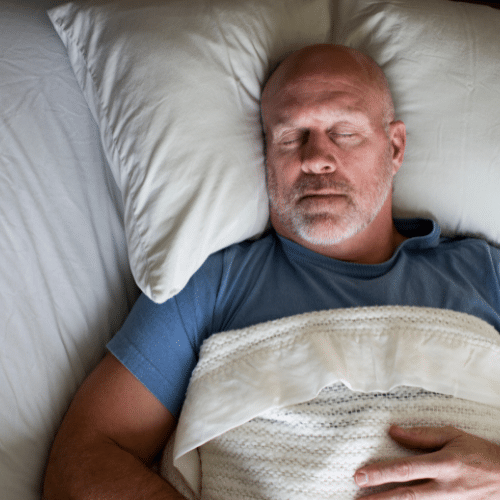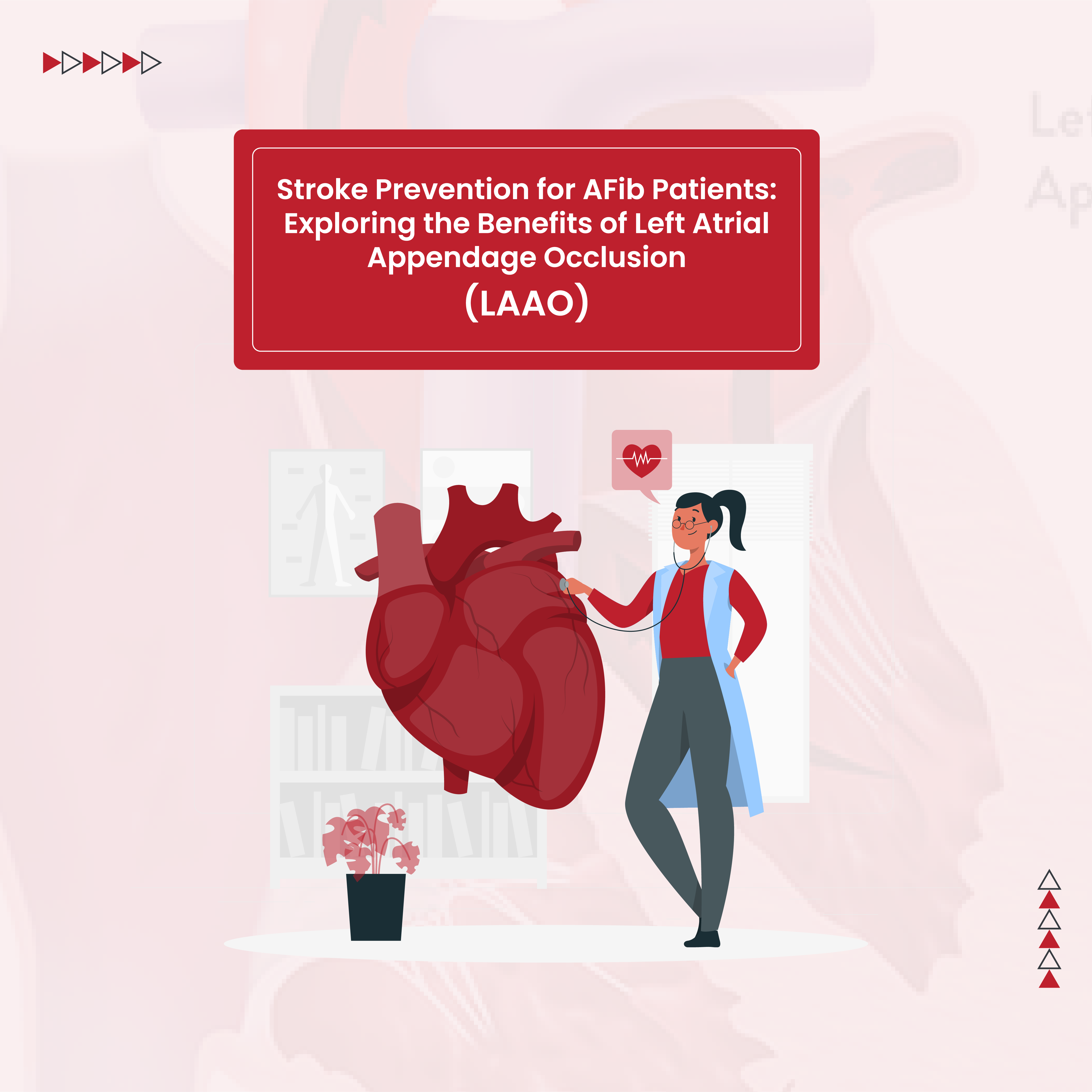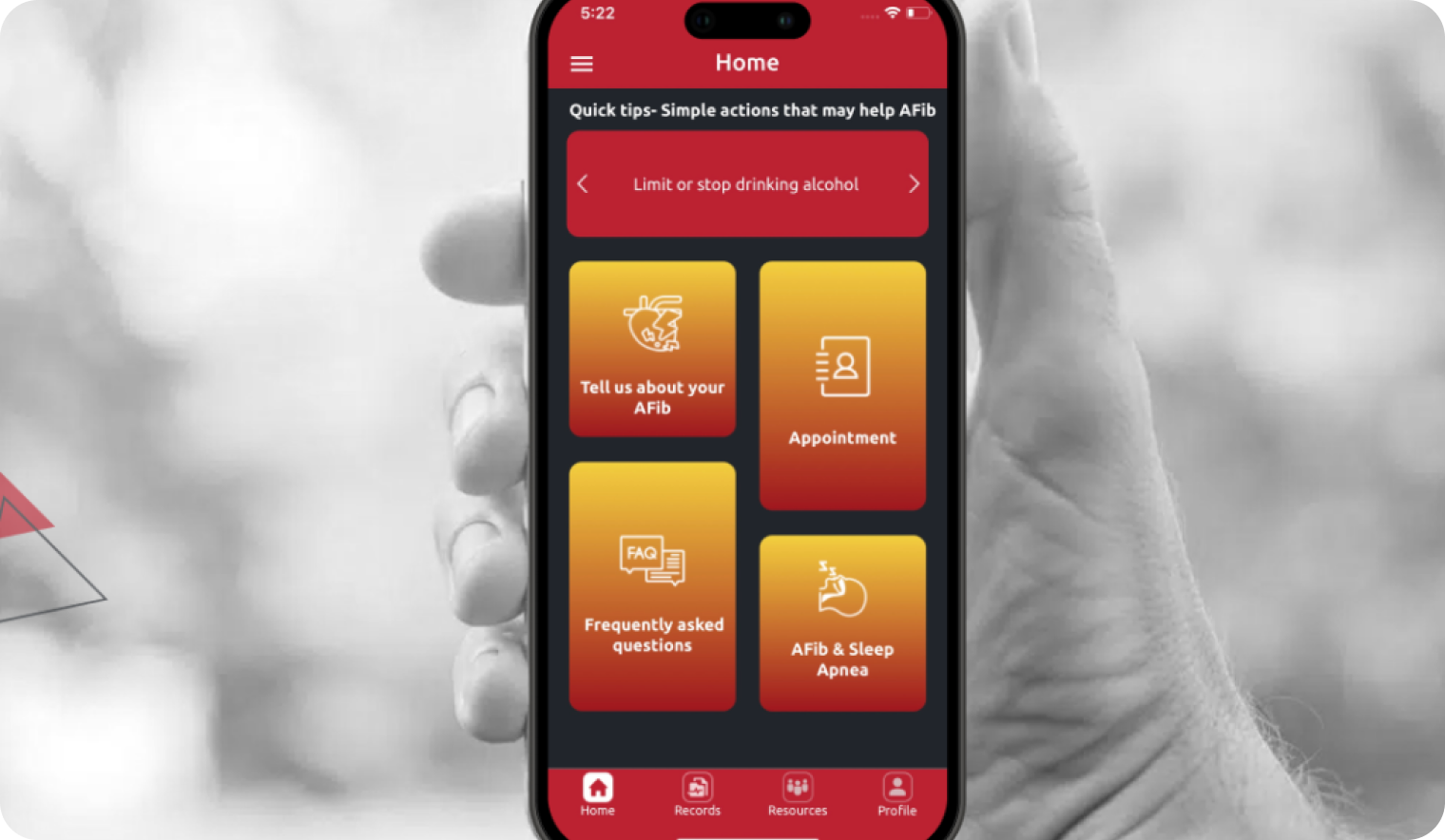Atrial fibrillation is the most common abnormal heart rhythm (arrhythmia). It affects over 18 million people in the United States and over 33.5 million people worldwide. AFib is a disorganized rhythm originating in the upper chambers of the heart, which causes the heart to beat irregularly and less effectively. People with AFib are at increased risk of heart failure and stroke.
Sleep apnea affects over 18 million people in the United States and 100 million worldwide and is a known risk factor for atrial fibrillation. People with sleep apnea have 4 times greater risk of developing AFib. In addition to increasing the risk of atrial fibrillation and other arrhythmias, sleep apnea can also lead to high blood pressure, heart disease, heart failure, stroke, diabetes, obesity and depression. It also causes decreased quality of life with patients reporting poor energy, daytime sleepiness, and mental fogginess. Despite the known short and long-term consequences, it remains underdiagnosed with research showing that up to 80% of patients go undiagnosed.
There are 3 types of sleep apnea: obstructive sleep apnea, central sleep apnea, and mixed sleep apnea in which the patient has both obstructive and central apneas. Obstructive sleep apnea is the most common kind of sleep apnea and is characterized by physical obstruction of the upper airway during sleep. The incidence of obstructive sleep apnea has increased with the increased prevalence of obesity. Central sleep apnea occurs when there is decreased stimulation of the breathing center in the brain which leads to decreased or ineffective breathing.
A person with sleep apnea stops breathing or breathes ineffectively intermittently throughout the night. This causes repeated periods of low oxygenation, which causes the person to awaken, either fully or partially. This process can occur hundreds of times per night. A person may or may not be aware of all of the episodes but may have a history of snoring, waking up choking or gasping for breath or someone may have observed periods where the person appeared to stop breathing during sleep.
What is the correlation between atrial fibrillation and sleep apnea?
It is estimated that 50% of people with atrial fibrillation have sleep apnea. Sleep apnea causes intermittent periods of low oxygen (hypoxemia) and fluctuations in blood pressure throughout the night. These changes put extra pressure on the heart and cause the body to release stress hormones. The stress hormones increase overall inflammation, damage blood vessels and upsets the balance and regulation of other hormones. Over time, the nightly struggle to breathe leads to structural changes within the heart and irritation of the heart’s electrical conduction system. Researchers think it is these structural changes coupled with the irritated electrical conduction system that are the link between sleep apnea and Afib.
Should people with AFib be screened for sleep apnea?
Treatment of atrial fibrillation should include assessment for sleep apnea because untreated sleep apnea decreases the efficacy of AFib treatment with either medication or catheter ablation. Patients with atrial fibrillation and obstructive sleep apnea have about a 30% increased risk of AFib recurrence after catheter ablation when compared to patients without sleep apnea. The American College of Cardiology guideline on atrial fibrillation that recommends assessment and treatment of underlying sleep apnea in patients with AFib. A recent study investigated the prevalence of undiagnosed sleep apnea in patients with AFib who were referred for catheter ablation. In the study, 82% of the patients with AFib, and no prior diagnosis of sleep apnea, were found to have sleep apnea on sleep testing.
Does treating sleep apnea have an impact on atrial fibrillation?
People with AFib and untreated sleep apnea are less likely to respond to atrial fibrillation treatments such as medications, cardioversion and catheter ablation. However, research has shown that patients with AFib and obstructive sleep apnea, which is being treated with CPAP therapy, have decreased recurrence of atrial fibrillation regardless of whether or not they have an ablation. A study of patients after catheter ablation showed a 42% reduction in recurrence of atrial fibrillation in patients with obstructive sleep apnea on CPAP therapy.
How do you screen for and diagnose sleep apnea?
Screening for sleep apnea includes assessing and identifying known risk factors for and complications of sleep apnea like AFib, obesity, high blood pressure, heart failure, diabetes and stroke. The process of screening for obstructive sleep apnea (OSA) commonly includes a validated sleep apnea screening tool, such as the STOP-BANG questionnaire and/or the Epworth Sleepiness scale. These assessments are not a substitute for sleep testing but give useful clinical information regarding how likely someone is to have obstructive sleep apnea and the severity of a person’s sleep apnea symptoms. See below for the STOP-BANG questionnaire. A score of less than 3 indicates low risk for OSA, 3-4 suggests intermediate risk and 5-8 high risk.
| STOP-BANG Questionnaire: One Point Awarded for Each Question Answered With “Yes”Snoring: Do you snore loudly (louder than talking or loud enough to be heard through closed doors)?Tired: Do you often feel tired, fatigued, or sleepy during daytime?Observed: Has anyone observed you stop breathing during your sleep?Blood Pressure: Do you have or are you being treated for high blood pressure?BMI: BMI more than 35 kg/m2?Age over 50 years old?Neck circumference greater than 40 cm (around 16in, measured by staff)?Gender male? Modified from Chung F, Yegneswaran B, Liao P, et al. STOP Questionnaire: a tool to screen patients for obstructive sleep apnea. Anesthesiology 2008:108;812-21. |
Sleep apnea is diagnosed using a sleep study, which can either be completed at home or in a sleep laboratory. A sleep test monitors breathing, oxygenation, and brain and heart activity while a person is sleeping. It records how frequently a person stops breathing or breathes ineffectively and determines the apnea hypopnea index (AHI). The AHI is the number of times per hour that a person either stops breathing (apnea) or breathes ineffectively (hypopnea). Sleep apnea is diagnosed if the AHI is greater than 5. An AHI greater than 30 is consistent with severe sleep apnea. To put this into context, an AHI of 30 means that on average a person either stops breathing or breathes ineffectively 30 times per hour, or once every 2 minutes, for the whole night. What this means is that while the body is supposed to be resting and repairing it is instead engaged in a nightly battle to keep breathing. With this perspective it becomes easier to appreciate why untreated sleep apnea can cause so many medical problems over time.

How do you treat sleep apnea?
Continuous positive airway pressure therapy (CPAP) is the most common first line treatment for sleep apnea. Effective CPAP therapy decreases respiratory events during sleep. This leads to improved sleep quality, decreased daytime sleepiness and improved quality of life.
Research has shown that CPAP significantly reduces the recurrence of atrial fibrillation. It is thought that the reduced physiologic strain of repeated intermittent apneas and hypopneas can help decrease the risk of the long-term complications of untreated sleep apnea like AFib, heart failure, heart disease and stroke. Current research is ongoing to help quantify the effect of CPAP on these diseases.
If a person’s sleep apnea is not adequately treated with CPAP, there are other, more sophisticated, positive airway pressure devices available. The ideal goal is to attain and maintain an AHI of less than 5 as this means that the sleep apnea is well treated.
Physical discomfort associated with CPAP use is one of the key barriers to use. Luckily, there are numerous mask design options available. Proper mask fit makes CPAP therapy more comfortable and effective. For some people, it can take time to get used to sleeping with a mask on. However, with some patience and persistence most people adjust to CPAP and many appreciate feeling rested after a good night’s sleep.
CPAP, or other positive airway pressure devices, are not the only treatment options available for sleep apnea. An oral appliance is an option for people with obstructive sleep apnea who decline or cannot tolerate CPAP. For some people, an obstruction in the nose or sinuses can cause obstructive sleep apnea. In these cases, repair of a deviated nasal septum or sinus surgery can be helpful. Certain types of central sleep apnea respond well to oxygen therapy.
Phrenic nerve stimulation is a newer treatment option for patients with central sleep apnea. Central sleep apnea occurs when the breathing center in the brain does not send the appropriate signals to the muscles of breathing, primarily the diaphragm. A phrenic nerve stimulator is an implantable device which monitors breathing patterns. If it senses that breathing has become too slow or shallow it stimulates the diaphragm, which initiates the next breath cycle.
Identifying underlying causes of sleep apnea is paramount in effectively treating sleep apnea. Obesity, heart failure, neurologic disorders, certain medications, drugs and alcohol can all cause or exacerbate sleep apnea. Any modifiable factors need to be addressed in order to improve a person’s outcomes. For example, if a person is obese and has an increased neck circumference there is more physical mass pushing down on the throat as the muscles relax during sleep. This worsens the obstruction of the upper airway. Therefore, weight loss would be an important part of this person’s sleep apnea treatment plan. Certain medications, drugs and alcohol cause excessive muscle relaxation and can worsen airway obstruction. They can also depress the breathing center in the brain and cause central sleep apnea. Again, if the underlying issue, in this case the medication, drug or alcohol, is not addressed the treatment of sleep apnea with CPAP alone will not be sufficient.
Should sleep apnea be considered when a person has atrial fibrillation?
Untreated sleep apnea can lead to atrial fibrillation, both its initial occurrence and recurrence. Therefore, assessment and treatment of sleep apnea is a vital part of successful treatment of atrial fibrillation. Fortunately, sleep apnea is very treatable. Many people with AFib and effectively treated sleep apnea have improved outcomes with their atrial fibrillation and report a better quality of life.








